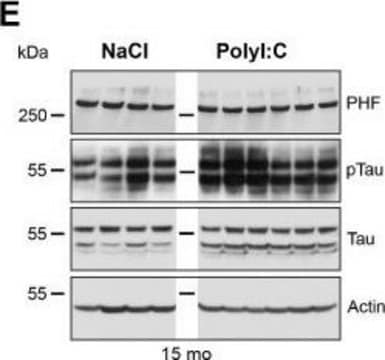CBL171-I
Anti-Aktin, Glattmuskel-Antikörper, Klon ASM-1/1A4
clone ASM-1 (1A4), from mouse
Synonym(e):
Actin, aortic smooth muscle, Alpha-actin-2, Cell growth-inhibiting gene 46 protein
About This Item
Empfohlene Produkte
Biologische Quelle
mouse
Qualitätsniveau
Antikörperform
purified immunoglobulin
Antikörper-Produkttyp
primary antibodies
Klon
ASM-1 (1A4), monoclonal
Speziesreaktivität
mouse, chicken, rat, human, bovine
Speziesreaktivität (Voraussage durch Homologie)
equine (based on 100% sequence homology)
Methode(n)
ELISA: suitable
immunocytochemistry: suitable
immunofluorescence: suitable
immunohistochemistry: suitable
western blot: suitable
Isotyp
IgG2aκ
NCBI-Hinterlegungsnummer
UniProt-Hinterlegungsnummer
Versandbedingung
wet ice
Posttranslationale Modifikation Target
unmodified
Angaben zum Gen
human ... ACTA2(59)
Allgemeine Beschreibung
Spezifität
Immunogen
Anwendung
Zellstruktur
Zytoskelettale Signalübertragung
Western Blotting Analysis: A representative lot detected smooth muscle actin in PC-3M-LN4 and PC-3M-LN4-derived human prostate cancer cells (Zvieriev, V., et al. (2005). Biochem. Biophys. Commun. 337(2):498-504).
Western Blotting Analysis: A representative lot detected developing stage-dependent vascular alpha-actin level in chicken heart of various somite stages (Ehler, E., et al. (2004). Dev. Dyn. 229(4):745-755).
Western Blotting Analysis: A representative lot detected aortic actin, but not actin from fibroblasts (beta- and gamma-cytoplasmic), striated muscle (alpha-sarcomeric), or myocardium (alpha-myocardial) in various human, rat, bovine and rabbit tissue and cell lysates (Skalli, O., et al. (1986). J. Cell Biol. 103(6 Pt 2):2787-2796).
Immunohistochemistry Analysis: A representative lot immunostained smooth muscle actin-positive myofibroblasts in paraformaldehyde-fix rat skin wounds sections (Mirastschijski, U., et al. (2010). Wound Repair Regen. 18(2):223-234).
Immunohistochemistry Analysis: A representative lot immunostained activated myofibroblasts in formalin-fixed, paraffin-embedded mouse submandibular salivary gland (Hall, B.E., et al. (2010). Lab. Invest. 90(4):543-555).
Immunohistochemistry Analysis: A representative lot immunostained α-SMA-positive cells in paraffin-embedded rat healing patellar tendon sections (Fu, S.C., et al. (2008). J. Orthop. Res. 26(3):374-383).
Immunocytochemistry Analysis: Representative lots immunostained the mesoderm layer of embryoid bodies formed in vitro from northern white rhinoceros iPSCs, as well as murine iPSCs and mESCs (Ben-Nun, I.F., et al. (2011). Nat. Methods. 8(10):829-831; Gerlach, J.C., et al. (2010). Cells Tissues Organs. 192(1):39-49; Shao, L., et al. (2009). Cell Res. 19(3):296-306).
Immunohistochemistry Analysis: A representative lot immunostained a subsets of cultured rat aortic medial smooth muscle cells (SMCs) and dermal fibroblasts (Skalli, O., et al. (1986). J. Cell Biol. 103(6 Pt 2):2787-2796).
Immunohistochemistry Analysis: A representative lot immunostained cultured rat tendon cells (Fu, S.C., et al. (2008). J. Orthop. Res. 26(3):374-383).
Immunofluorescence Analysis: A representative lot immunostained myofibrils using methanol-fixed, 9-somite stage chicken heart whole-mount preparations. The vascular alpha-actin staining started to disappear from a subset of the myofibrils when using 10-somite stage chicken heart preparations (Ehler, E., et al. (2004). Dev. Dyn. 229(4):745-755).
Immunofluorescence Analysis: A representative lot immunostained stromal vessel SM cells in acetone-fixed benign (leiomyomas) and malignant (leiomyosarcomas & intravascular leiomyomatosis) smooth muscle (SM) neoplasms cryosections (Schürch, W., et al. (1987). Am. J. Pathol. 128(1):91-103).
Immunofluorescence Analysis: A representative lot immunostained chicken gizzard and rat myocardium blood vessels, as well as smooth muscle cells (SMCs) in various acetone-fixed human and rat cryosections, whereas chicken gizzard parenchyrnal cells, rat cardiocytes, aorta endothelial cells and adventitial fibroblasts were negative (Skalli, O., et al. (1986). J. Cell Biol. 103(6 Pt 2):2787-2796).
ELISA Analysis: A representative lot detected aortic actin, but not actin from fibroblasts (beta- and gamma-cytoplasmic), striated muscle (alpha-sarcomeric), or myocardium (alpha-myocardial) by ELISA (Skalli, O., et al. (1986). J. Cell Biol. 103(6 Pt 2):2787-2796).
Qualität
Western-Blot-Analyse: 0,5 µg/ml dieses Antikörpers wies Glattmuskelaktin in 10 µg HUVEC-Lysat nach.
Zielbeschreibung
Physikalische Form
Lagerung und Haltbarkeit
Sonstige Hinweise
Haftungsausschluss
Not finding the right product?
Try our Produkt-Auswahlhilfe.
Lagerklassenschlüssel
12 - Non Combustible Liquids
WGK
WGK 1
Flammpunkt (°F)
Not applicable
Flammpunkt (°C)
Not applicable
Analysenzertifikate (COA)
Suchen Sie nach Analysenzertifikate (COA), indem Sie die Lot-/Chargennummer des Produkts eingeben. Lot- und Chargennummern sind auf dem Produktetikett hinter den Wörtern ‘Lot’ oder ‘Batch’ (Lot oder Charge) zu finden.
Besitzen Sie dieses Produkt bereits?
In der Dokumentenbibliothek finden Sie die Dokumentation zu den Produkten, die Sie kürzlich erworben haben.
Unser Team von Wissenschaftlern verfügt über Erfahrung in allen Forschungsbereichen einschließlich Life Science, Materialwissenschaften, chemischer Synthese, Chromatographie, Analytik und vielen mehr..
Setzen Sie sich mit dem technischen Dienst in Verbindung.








